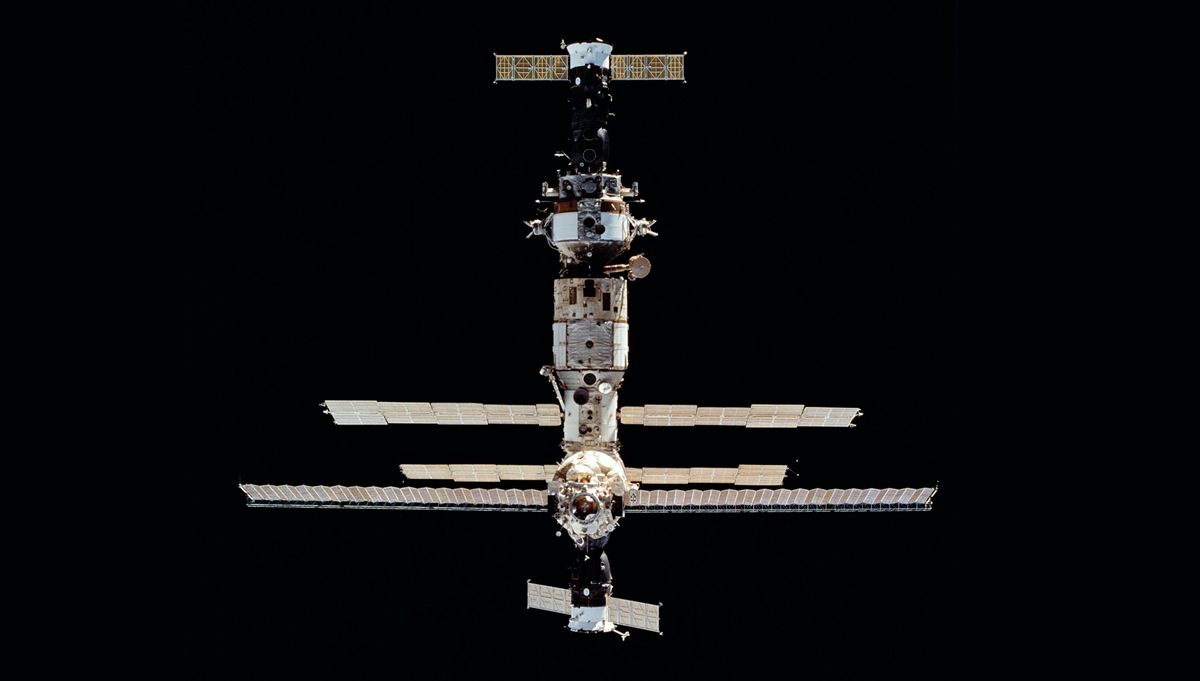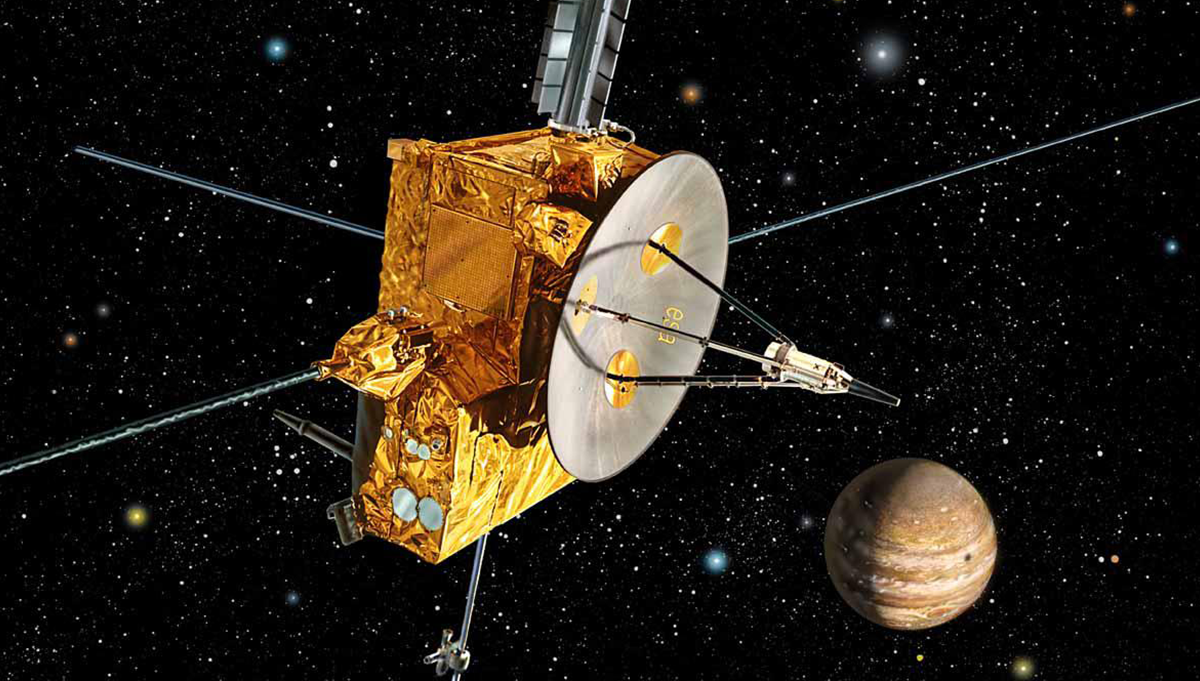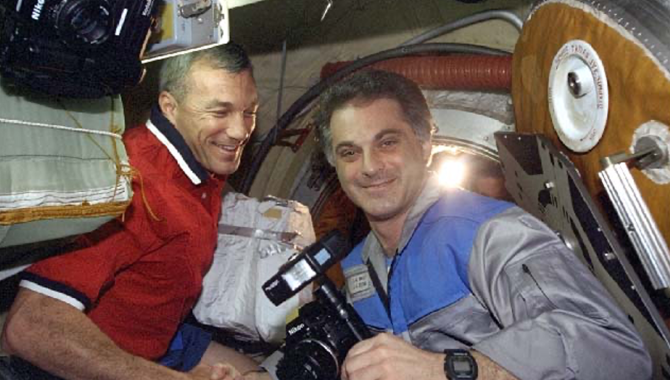
STS-89 Commander Terrence Wilcutt, left, greets Mission Specialist David Wolf at the airlock of Space Shuttle Endeavour, following Wolf’s 128-day mission aboard the Mir space station. It was a reunion in space for Wilcutt and Wolf, who were both from NASA Astronaut Group 13.
Credit: NASA
STS-89 reunites members of NASA Astronaut Group 13.
On January 22, 1998—25 years ago this month—the Space Shuttle Endeavour lit the night sky along Florida’s Space Coast as it launched from Kennedy Space Center on mission STS-89. Loaded with approximately 7,000 pounds of supplies and experiments, it was the eighth of nine NASA missions to the Mir space station.
For Commander Terrence W. Wilcutt, it was a return to Mir. He had been the Pilot of STS-79, which docked with Mir on September 19, 1996. “Just a beautiful thing up in space orbiting the Earth. I don’t have a better word to describe it. It fills you with hope and wonder really to think about people living up there, because it is a remote outpost,” he recalled in an oral history in 2016.
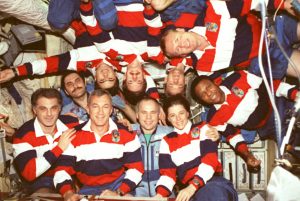
Ten astronauts and cosmonauts form a human oval in order to fit into a single frame, onboard Russian Mir Space Station’s Base Block, the traditional in-flight crew portrait.
Credit: NASA
This was Wilcutt’s third spaceflight, but first as Commander. Pilot Joe F. Edwards, Jr., and Mission Specialists Michael P. Anderson, James F. Reilly, and Cosmonaut Salizhan Sharipov were all making their first spaceflight. Payload Commander Bonnie J. Dunbar was making her fifth and final spaceflight. Andrew S. W. Thomas, who launched with the crew to begin a stint aboard Mir, and David A. Wolf, who ended a stint on Mir and returned on STS-89, were both on their second spaceflights.
“…Everyone has their own style of commanding. You may have to alter your usual style based on who you get, but literally the crew, we all bonded almost immediately. One, it’s a pretty exciting thing to be assigned. But gosh, to a person, they were really wonderful crew members. … We, as a matter of routine, backed each other up on everything that we did to make sure that it was successful,” Wilcutt recalled.
“Being the commander, you’re ultimately responsible for the safety and success of the crew, the ship, the mission. You’re assigned that way. You assume those duties. It’s not the first thing you’ve been in charge of, whether it’s a department in either your previous job, like in the military, or a flight of airplanes going someplace, or some branch in the Astronaut Office. … You bring whatever leadership skills and history that you have [from] those positions. Like all good commanders, you adapt to make sure that you’re successful in the end. That’s it,” he explained.

From the point of view of the Space Shuttle Endeavour, the Mir Space Station rapidly approaches as the two spacecraft prepare to make the eighth of nine NASA-Mir link-ups.
Credit: NASA
Wilcutt had the opportunity to perform a new docking maneuver with Mir, one that took advantage of orbital mechanics to conserve fuel. The maneuver called for the accomplished fighter pilot to guide Endeavour in a very narrow window at a very slow speed to bring the two spacecrafts together.
“…It’s just a delicate operation. … But frankly, the Shuttle was engineered so well, and it flew so well that that wasn’t a difficult thing to achieve. And we’re trained so well. The training teams don’t get enough credit for that. They’ve looked at every single one of these things. They evaluate anything that could possibly go wrong and then make sure you experience that and you’re comfortable with the procedures to either prevent it or to recover from it, then they turn you loose,” Wilcutt recalled.
Wolf had arrived at Mir aboard STS-86 in September 1997. It was a reunion for Wolf and Wilcutt, who were both from NASA Astronaut Group 13, selected in 1990. Wolf had trained extensively for his time aboard the space station, including survival training north of the Arctic Circle and in the Black Sea, facing temperatures as low as 40 degrees below zero.
“That’s excellent for camaraderie and learning how people respond under stresses, not just to learn how to live when you land—if you happen to land in such a region. …It has other side benefits, perhaps more important, to learn how to get through the next hour, hour by hour, and stick to [a] task that’s very difficult,” Wolf recalled in an oral history.
Wolf was originally scheduled to arrive at Mir aboard STS-89, but as he trained as the backup to Wendy B. Lawrence for STS-86, there were concerns about how the Russian Orlan EVA spacesuit fit Lawrence. “The training accelerated a lot in the last month because suddenly I was going flying in a month or so instead of six months or five months. I was a back-up, and that was invoked very late in the game,” Wolf recalled.
“We squeezed a whole EVA program that might take six months, or more, into a month—or three weeks, actually—which took basically morning through evening, [including weekends,] in the water tank. Almost every day, in laboratories and pressurized suits and vacuum chambers or in the classroom,” Wolf recalled.
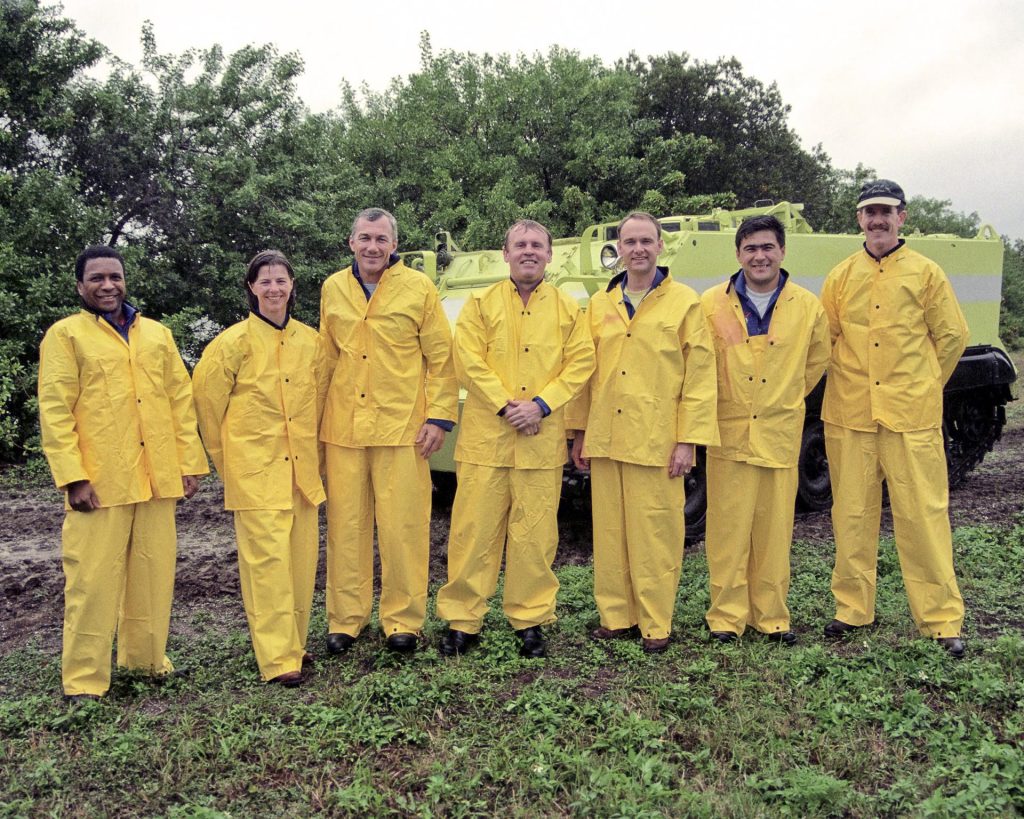
The STS-89 crew members pose in front of an M-113 armored personnel carrier while participating in Terminal Countdown Demonstration Test TCDT activities. Posing, from left to right, are Mission Specialist Michael P. Anderson, Payload Commander Bonnie J. Dunbar, Commander Terrence W. Wilcutt, Mission Specialist Andrew S.W. Thomas, Pilot Joe F. Edwards, Jr., and Mission Specialist Salizhan Sharipov, a cosmonaut with the Russian Space Agency, and James F. Reilly.
Credit: NASA
“When I was nine years old, I saw Ed White do the first American spacewalk, and it was that moment that I decided I’d like to be an astronaut and, in fact, I’d like to do a spacewalk as an astronaut,” Wolf said. “It was thirty-one years later that I did it. It was worth every minute of the wait.”
STS-89 returned to Earth on January 31, landing at Kennedy Space Center, with Endeavour’s front wheels coming to a rest perfectly on the centerline stripe of the runway. The landing, Wilcutt recalled, was exactly what he had come to expect after making more than 1,000 training landings in the Shuttle Training Aircraft.
Wolf, who had spent 128 days in space, and nearly two years away from his day-to-day life while training and preparing for the mission, found the experience of returning to Earth to be profound. He recalled savoring his morning stop at a convenience store for a cup of coffee.
“Well, just as the mission doesn’t end when you land, the mission doesn’t start when you launch. …There’s a lot of relationships to reestablish, your house, various equipment. I have an airplane that needs a lot of work now, and it’s two years of chores all saved up and trying to, one by one, get through those. You can’t go see all your friends and family all at once, so there’s a certain emptiness there. …You need to start reestablishing relationships that have been years delayed,” Wolf recalled.
Visit APPEL KS’s Shuttle Era Resources Page to learn more about STS-45 and the other 134 shuttle missions over 30 years, missions that deployed key satellites, repaired the Hubble Space Telescope, enabled important new research, and were instrumental in construction of the International Space Station. The Shuttle Era Resources Page also contains important resources on the Challenger and Columbia accidents and enduring lessons learned.






